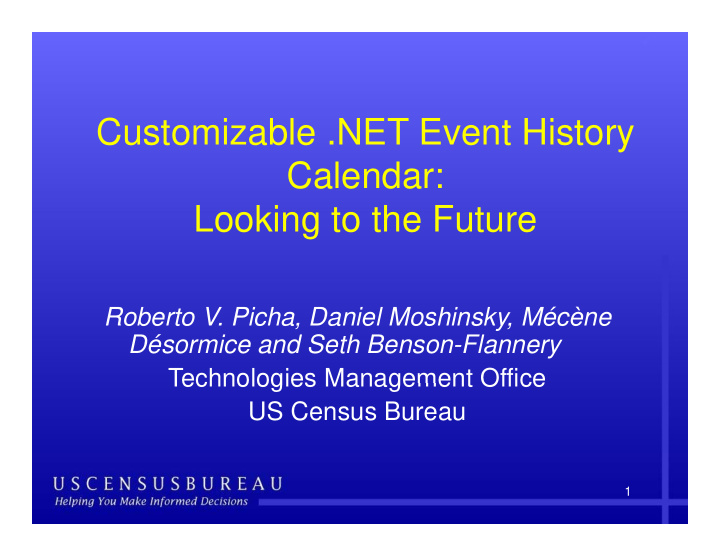



Customizable .NET Event History Calendar: Calendar: Looking to the Future Roberto V Picha Daniel Moshinsky Mécène Roberto V. Picha, Daniel Moshinsky, Mécène Désormice and Seth Benson-Flannery Technologies Management Office Technologies Management Office US Census Bureau 1
Outline • (Re-)Introducing ReSIPP • Results of this year's Field Test • Requirements for the next Field Test • New design and implementation N d i d i l i 2
What is SIPP? What is SIPP? • Very large national survey of income, program use, and wealth • Currently being conducted quarterly, in CASES CASES • Respondents interviewed every four months p y 3
What is Re-Engineered SIPP? What is Re Engineered SIPP? • To cut costs, shifting to annual interviewing (Re-enginnered SIPP – ReSIPP) • Use Event History Calendar (EHC) to help with longer recall with longer recall • Series of field tests prior to final deployment p p y
2010 Field Test • Almost 8,000 cases in sample Al t 8 000 i l • Half of ReSIPP questions asked in the DEP, half in the EHC half in the EHC • EHC is a .NET COM object DLL launched from the DEP. • Many many questions were being asked in the EHC • Described in detail at last conference 5
Results of 2010 Field Test • Issues with survey content: – interview was too long, – questions too repetitive i i i – Respondents often frustrated by the length of the interview – e.g.: “Who in your HH is covered by this program?” is asked and re-asked of everyone in HH HH. 6
More 2010 Results • Navigation within the EHC was not a big issue despite concerns • No technical issues or significant glitches • Initial data analysis shows data compares well to existing SIPP – (preliminary findings well to existing SIPP (preliminary findings only) 7
Goal of 2011 Field Test • Sponsors and field staff wanted us to help them create – a smarter and t d – quicker interview experience. 8
Requirements for 2011 Test • Reference period increased to 13-18 months to help feed info into subsequent waves • A lot of data needs to be copied during the interview between HH members in order to interview between HH members, in order to get rid of redundant questions (e.g. Residency, Marital Status) 9
More 2011 Requirements • Calculate the “Time without a job” periods dynamically based on gaps of employment, and put on route follow up questions about and put on route follow-up questions about those periods • Improve processing of complex rules statements and edit checks 10
New Design • Use the EHC primarily to display and enter calendar dates • Return to the DEP for follow-up questions that were asked in the EHC in 2011 were asked in the EHC in 2011 • Streamline GUI interface of the EHC and Streamline GUI interface of the EHC and make navigation more intuitive 11
12
13 Movie Time!
Implementation Details Implementation Details • Use of flags to exchange data from DLL to DEP t DEP to put blocks on path t bl k th • Attaching DLL to end fields in the DEP and • Attaching DLL to end fields in the DEP and returning to EHC, placing the focus on the desired topic p • Data structure remained the same as previous release 14
Transition issues • Fairly painless, quick transition thanks to the customizable design of the EHC object • Copying data between HH members – extensive use of Manipula extensive use of Manipula • Dynamic creation of periods of “time without a Dynamic creation of periods of time without a job” 15
Transition issues, continued Transition issues, continued • Single audit trail implemented – Set CloseFile =1 in .aif file – Much easier to read than multiple audit trail files. – Easier to automate re-keying of data – Easily adaptable so that we may write paradata to – Easily adaptable so that we may write paradata to the audit trail 16
Conclusions Conclusions • Attempted to make instrument “smarter” • A more efficient, less frustrating instrument • Proved that our design of the EHC was truly customizable customizable. • Appreciation for robustness of DEP and Appreciation for robustness of DEP and Manipula 17
Questions or comments? • Contact information: – Roberto Picha roberto.v.picha@census.gov 301-763-7730 301-763-7730 – Daniel Moshinsky daniel.y.moshinsky@census.gov 301-763-7712 – Mécène Désormice mecene.desormice@census.gov 301-763-7725 – Seth Benson-Flannery seth.p.benson-flannery@census.gov Seth Benson Flannery seth p benson flannery@census gov 301-763-7723 18
Recommend
More recommend